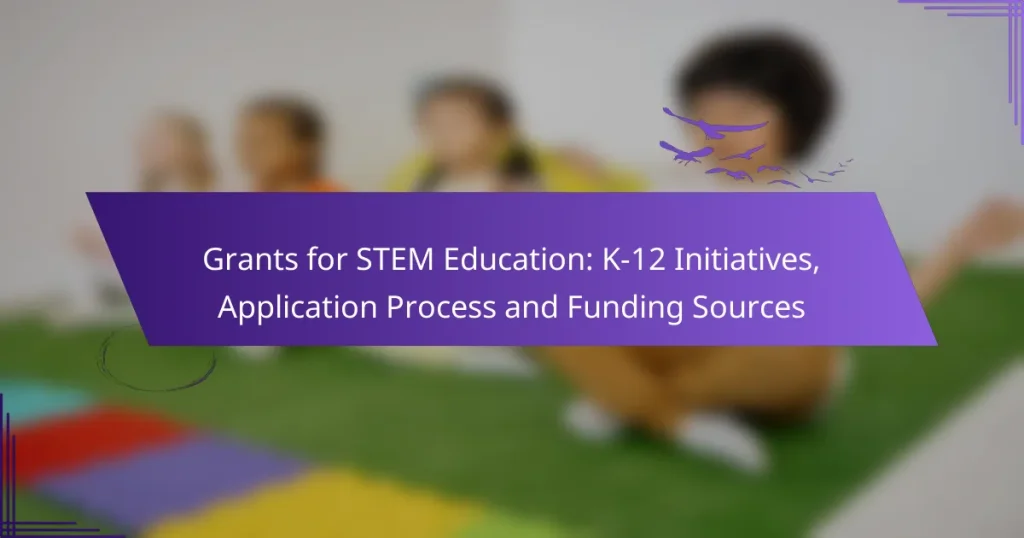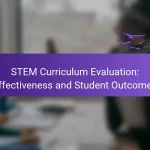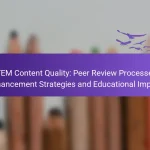Grants for K-12 STEM education provide essential funding to enhance science, technology, engineering, and mathematics learning in schools across the United States. These grants, offered by federal agencies, private foundations, and local education agencies, support innovative programs and teacher training. To secure funding, schools must identify appropriate opportunities and submit a detailed application that outlines their project’s goals, budget, and expected outcomes.
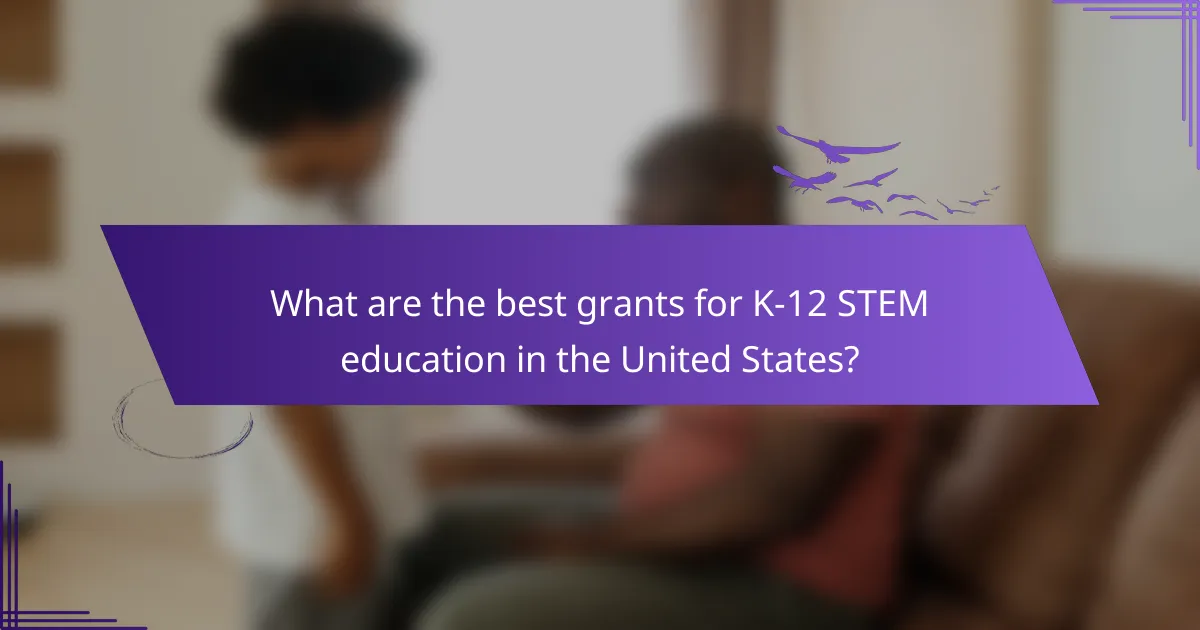
What are the best grants for K-12 STEM education in the United States?
The best grants for K-12 STEM education in the United States come from various federal agencies, private foundations, and local education agencies. These grants aim to enhance science, technology, engineering, and mathematics education through funding for innovative programs, resources, and teacher training.
National Science Foundation Grants
The National Science Foundation (NSF) offers several grant programs specifically designed to improve K-12 STEM education. These grants typically focus on research and development of new educational strategies, curricula, and teaching methods.
One popular NSF program is the Innovative Technology Experiences for Students and Teachers (ITEST), which funds projects that engage students in STEM through hands-on experiences. Schools can apply for grants ranging from tens of thousands to several million dollars, depending on the project’s scope.
Department of Education Grants
The U.S. Department of Education provides various grants aimed at enhancing STEM education in K-12 schools. Notable programs include the Supporting Effective Instruction (SEI) and the 21st Century Community Learning Centers (21st CCLC) grants, which support innovative teaching practices and after-school STEM programs.
Applications for these grants often require a detailed proposal outlining the project’s goals, expected outcomes, and budget. Schools can receive funding from a few thousand to millions of dollars based on the program’s requirements and the number of students served.
NASA STEM Engagement Grants
NASA offers STEM Engagement Grants to support educational initiatives that inspire students to pursue careers in science and engineering. These grants often focus on projects that incorporate NASA’s resources, such as space missions and research, into the classroom.
Funding amounts can vary significantly, but many grants range from $5,000 to $100,000. Schools and organizations should align their proposals with NASA’s mission and demonstrate how their projects will engage students in STEM learning.
Private Foundation Grants
Numerous private foundations provide grants for K-12 STEM education, including the Bill & Melinda Gates Foundation and the Siemens Foundation. These organizations often fund innovative projects that aim to improve educational outcomes and increase student engagement in STEM fields.
Grant amounts from private foundations can vary widely, typically ranging from $10,000 to over $500,000. Applicants should carefully review each foundation’s priorities and guidelines to tailor their proposals effectively.
Local Education Agency Grants
Local education agencies (LEAs) often have grant opportunities available for K-12 STEM initiatives. These grants may be funded through state budgets or local partnerships and are designed to support specific community needs.
Funding amounts can be modest, often between $1,000 and $50,000, and may require collaboration with local businesses or organizations. Schools should explore their LEA’s website or contact administrators to learn about available grants and application processes.
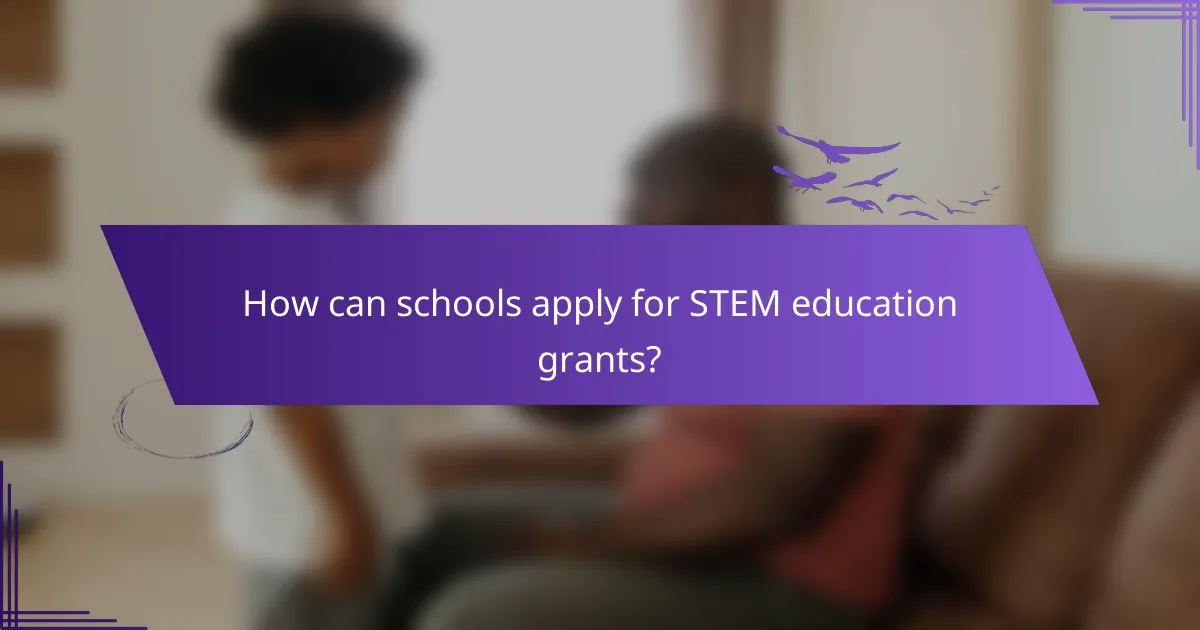
How can schools apply for STEM education grants?
Schools can apply for STEM education grants by identifying suitable funding opportunities and submitting a well-prepared application. This process typically involves outlining the project’s goals, budget, and expected outcomes to demonstrate the initiative’s value.
Application Process Overview
The application process for STEM education grants generally begins with researching available grants from federal, state, and private sources. Schools should assess eligibility criteria and deadlines to ensure they meet all requirements before proceeding.
Once a suitable grant is identified, schools must prepare a comprehensive proposal. This includes detailing the project plan, objectives, and how the funding will be utilized. Collaboration with stakeholders, such as teachers and community members, can strengthen the application.
Key Documentation Required
Additionally, schools should prepare a detailed narrative that outlines the project’s goals, methodologies, and anticipated impact on students. Having these documents organized and readily available can streamline the application process.
Common Application Mistakes
One common mistake in applying for STEM education grants is failing to follow the specific guidelines set by the funding agency. Each grant may have unique requirements regarding format, length, and content, which must be adhered to for a successful application.
Another frequent error is underestimating the importance of a clear budget. Schools should ensure that their budget aligns with the project goals and is justified with appropriate details. Incomplete or vague budgets can lead to disqualification or reduced funding.
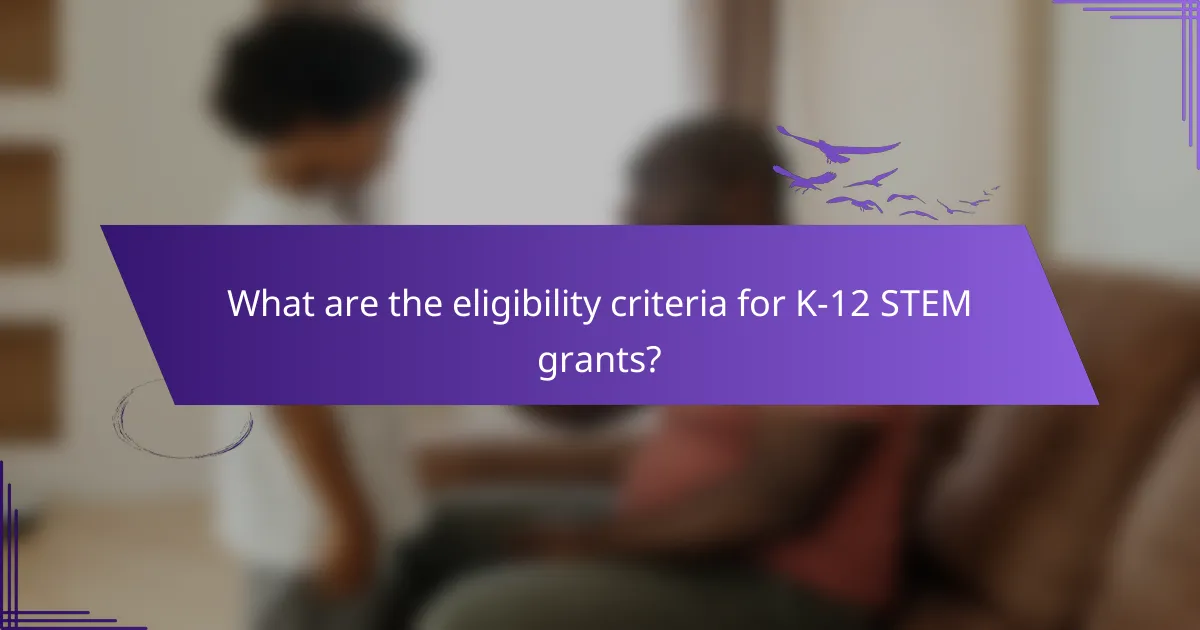
What are the eligibility criteria for K-12 STEM grants?
K-12 STEM grants typically require applicants to meet specific eligibility criteria, which may include being a public or private school, demonstrating a commitment to STEM education, and aligning projects with state or national educational standards. Additionally, applicants often need to show how their initiatives will enhance student engagement and learning in science, technology, engineering, and mathematics.
School District Requirements
To qualify for K-12 STEM grants, school districts must usually demonstrate their capacity to support STEM initiatives. This can include having a dedicated STEM curriculum, qualified staff, and resources to implement the proposed projects effectively. Some grants may also require districts to show collaboration with local businesses or higher education institutions.
Additionally, districts may need to provide evidence of previous successful projects or initiatives that align with STEM education goals, which can strengthen their application.
Project Scope and Goals
The project scope for K-12 STEM grants should clearly define the objectives and outcomes expected from the initiative. This includes detailing the specific STEM areas the project will address, such as robotics, coding, or environmental science. Goals should be measurable and aligned with broader educational standards to demonstrate their impact on student learning.
Applicants should also consider including innovative teaching methods or technologies that will engage students and enhance their learning experiences. Clearly articulating how the project will benefit students and the community can significantly improve the chances of receiving funding.
Funding Amounts and Duration
K-12 STEM grants can vary widely in funding amounts, typically ranging from a few thousand to several hundred thousand dollars, depending on the grant program and project scope. Applicants should research specific grants to understand the funding limits and any matching funds that may be required.
The duration of funding can also differ, with some grants providing support for a single year while others may offer multi-year funding. It is crucial for applicants to outline how they will sustain the project beyond the grant period, as this can be a key consideration for grant reviewers.
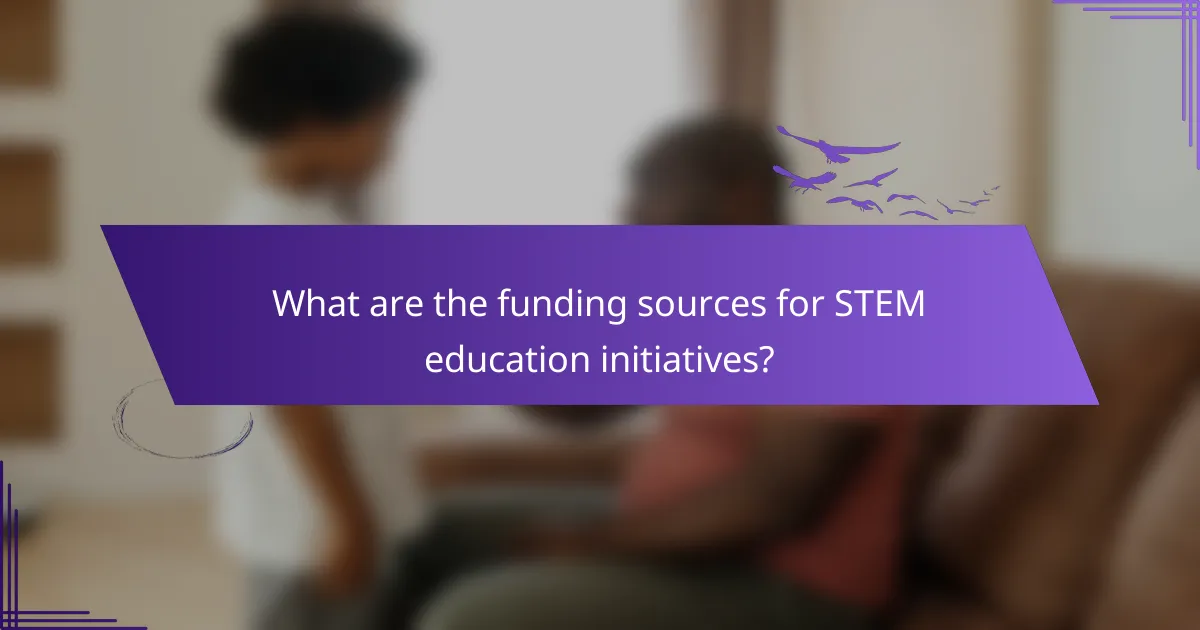
What are the funding sources for STEM education initiatives?
Funding sources for STEM education initiatives include federal and state programs, as well as corporate sponsorships. Each source offers unique opportunities and requirements, making it essential for K-12 institutions to explore all available options.
Federal Funding Sources
Federal funding for STEM education typically comes from grants administered by agencies such as the National Science Foundation (NSF) and the Department of Education. These grants often target specific projects or programs aimed at enhancing STEM learning in K-12 schools.
To apply for federal funding, schools must follow a structured process that includes submitting detailed proposals outlining project goals, budgets, and expected outcomes. It’s crucial to align proposals with federal priorities, which may include promoting equity in education or integrating technology into classrooms.
State Funding Programs
Many states offer their own funding programs for STEM education, which can vary significantly in terms of eligibility and application processes. These programs may include grants, scholarships, or matching funds aimed at supporting local initiatives.
Schools should research their state’s education department website for specific funding opportunities and guidelines. Engaging with local education agencies can also provide insights into upcoming funding cycles and collaborative opportunities.
Corporate Sponsorships
Corporate sponsorships are another viable funding source for STEM education initiatives. Many companies, especially those in technology and engineering sectors, are eager to support educational programs that align with their business interests.
To secure corporate sponsorships, schools should identify potential partners and develop proposals that highlight mutual benefits, such as branding opportunities or workforce development. Building relationships with local businesses can lead to long-term partnerships that provide ongoing support for STEM initiatives.

What are the best practices for writing a successful grant proposal?
Successful grant proposals clearly communicate the project’s goals, budget, and community involvement. Focusing on these elements increases the likelihood of securing funding for STEM education initiatives.
Clear Objectives and Outcomes
Defining clear objectives and measurable outcomes is crucial for a successful grant proposal. Objectives should be specific, achievable, and relevant to the STEM education goals you aim to address.
For example, instead of stating “improve student engagement,” specify “increase student participation in STEM clubs by 30% over the academic year.” This clarity helps reviewers understand the project’s impact and feasibility.
Budget Justification
A well-structured budget justification outlines how funds will be allocated and why each expense is necessary. Break down costs into categories such as personnel, materials, and technology to provide transparency.
For instance, if you plan to purchase new laboratory equipment, include details on the specific items and their costs. This helps justify the total funding request and demonstrates responsible financial planning.
Engagement with Community Partners
Engaging with community partners enhances the credibility of your proposal and can provide additional resources. Collaborate with local businesses, educational institutions, or non-profits that share your STEM education goals.
For example, partnering with a local university for mentorship programs can strengthen your proposal by showcasing community support and shared investment in student success. Highlight these partnerships to illustrate a broader impact and resource network.
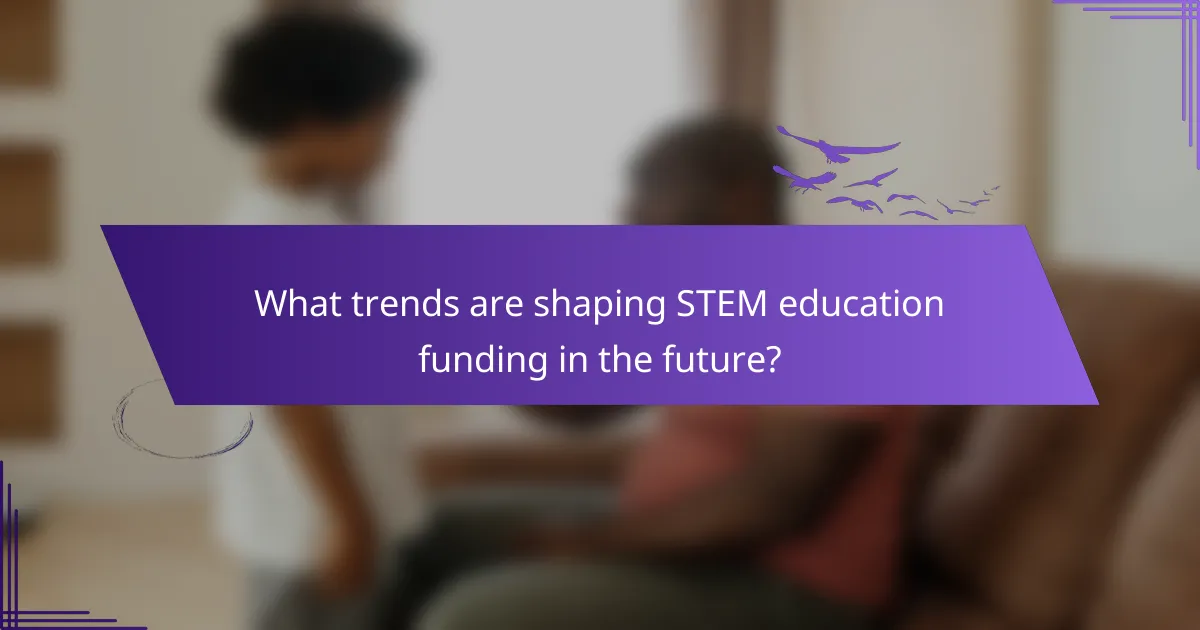
What trends are shaping STEM education funding in the future?
Future trends in STEM education funding are increasingly focused on equity, innovation, and collaboration. As educational needs evolve, funding sources are adapting to support diverse initiatives that enhance access and engagement in STEM fields.
Increased focus on equity in STEM funding
Equity in STEM education funding aims to ensure that all students, regardless of background, have access to quality resources and opportunities. This trend is driven by a growing recognition of disparities in educational outcomes among different demographic groups.
Funding initiatives are now prioritizing underserved communities, with grants specifically designed to support schools in low-income areas. Programs that provide mentorship, resources, and training for educators are becoming more common, helping to bridge the gap in STEM education.
Emphasis on innovative teaching methods
Innovative teaching methods are gaining traction as a key focus for STEM funding. This includes the integration of technology, hands-on learning experiences, and project-based curricula that engage students in real-world problem-solving.
Grants are increasingly supporting programs that utilize robotics, coding, and other advanced technologies to enhance student learning. Schools are encouraged to adopt these methods to foster creativity and critical thinking skills, which are essential for success in STEM careers.
Collaboration between schools and industry
Collaboration between educational institutions and industry partners is becoming a vital trend in STEM funding. Such partnerships can provide schools with resources, expertise, and real-world applications of STEM concepts.
Funding opportunities are often available for programs that facilitate internships, mentorships, and joint projects between students and local businesses. These collaborations not only enhance student learning but also help to align educational outcomes with workforce needs, creating a more skilled labor pool.
